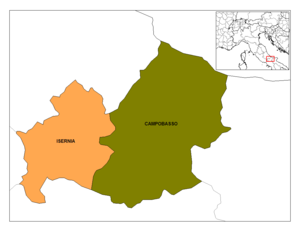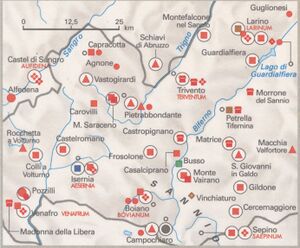موليزى
Molise
| |
|---|---|
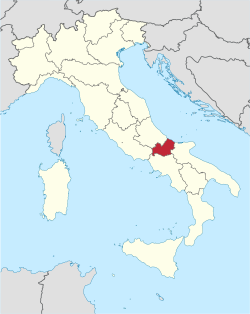 | |
| الإحداثيات: 41°41′59″N 14°36′40″E / 41.6997°N 14.6111°E | |
| Country | Italy |
| Capital | Campobasso |
| الحكومة | |
| • President | Francesco Roberti (FI) |
| المساحة | |
| • الإجمالي | 4٬438 كم² (1٬714 ميل²) |
| التعداد (31-12-2017) | |
| • الإجمالي | 308٬493 |
| • الكثافة | 70/km2 (180/sq mi) |
| صفة المواطن | إنگليزية: Molisan إيطالية: Molisano (man) إيطالية: Molisana (woman) |
| GDP | |
| • Total | €6.452 billion (2021) |
| منطقة التوقيت | UTC+1 (CET) |
| • الصيف (التوقيت الصيفي) | UTC+2 (CEST) |
| ISO 3166 code | IT-67 |
| HDI (2021) | 0.874[2] very high · 15th of 21 |
| NUTS Region | ITF |
| الموقع الإلكتروني | www.regione.molise.it |
موليزى Molise أحدالأقاليم العشرين المكونة للأراضي الإيطالية، يقع جنوب إيطاليا، يطل شرقا على البحر الأدرياتي، حدوده من الشمال إقليم أبروتسو، و من الغرب إقليم لاتسيو، ومن الجنوب الغربي إقليم كامبانيا، ومن الجنوب الشرقي إقليم بوليا، تعداد سكانه حوالي 322.000 نسمة ، ومساحته 4.438 كيلومتر مربع تتكون من مقاطعتين هما كامپوباسو، وإيزرنيا. Covering 4،438 متر كيلومربع (1،714 sq mi), it is the second smallest region in the country, after the Aosta Valley, and has a population of 313,348 (as of 1 January 2015).
The region is split into two provinces, named after their capitals: Campobasso and Isernia. Campobasso also serves as the regional capital.
التقسيمات الإدارية
تتكون موليزى من مقاطعتين:
| المقاطعة | المساحة (كم²) | التعداد | الكثافة (نسمة/كم²) |
|---|---|---|---|
| مقاطعة كامبوباسو | 2,909 | 231,921 | 79.7 |
| مقاطعة إيزرنيا | 1,529 | 88,931 | 58.2 |
أهم المدن
| المدينة | الاسم بالإيطالية | المقاطعة | السكان |
|---|---|---|---|
| 1. كامبوباسو | Campobasso | كامبوباسو | 51.185 |
| 2. تيرمولي | Termoli | كامبوباسو | 31.006 |
| 3. إزيرنيا | Isernia | إزيرنيا | 21.720 |
| 4. فينافرو | Venafro | إزيرنيا | 12.000 |
Geography
Molise is bordered by Abruzzo to the north, Apulia to the east, Lazio to the west, and Campania to the south. It has 35 كيلومتر (22 ميل) of sandy coastline to the northeast, lying on the Adriatic Sea looking out toward the Tremiti Islands. The countryside of Molise is mostly mountainous, with 55% covered by mountains and most of the rest by hills that go down to the sea.[3]
Main sights and monuments
Campobasso
- Castello Monforte
- Terzano Tower
- Campobasso Cathedral (Santissima Trinità)
- Church of Sant'Antonio
- Church of San Bartolomeo
- Church of San Giorgio
- Savoia Theater
- San Giorgio Palace (Head of municipality)
- Provincial Museum of "Sanniti"
Isernia
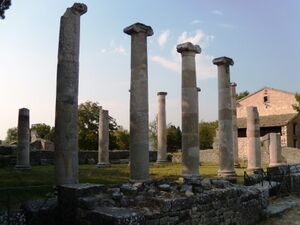
- Isernia Cathedral (San Pietro)
- Fountain Fraterna
- Monumental complex and museum of Santa Maria delle Monache Abbey
- Sanctuary of Santi Cosma e Damiano
- Archeological site Isernia La Pineta
- Museum of Paleolithic in the site of La Pineta
Termoli
- Cathedral of San Basso from Lucera
- Medieval castle of Frederick II
- Sinarca Tower
- Rinascimental Gallery Museum
Venafro
- Castle Pandone
- Venafro Cathedral
- Archeogical Museum of Venafro
- War Museum Winterline Venafro
Province of Campobasso
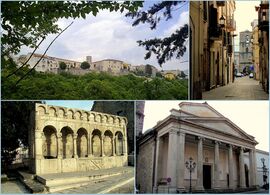
- Trivento Cathedral
- Church of Santa Maria Maggiore (Guglionesi)
- Santuario di Santa Maria del Canneto (Roccavivara)
- Caldora Castle (Carpinone)
- Castle Anjou (Civitacampomarano)
- Longobard Castle (Tufara)
- Bojano Cathedral (San Bartolomeo)
- Medieval fortress Civita Superiore (Bojano)
- Angioina Tower (Colletorto)
- Larino Cathedral
- Archeological site and Roman theater of Larinum (Larino)
- Archeological site and museum of Altilia (Sepino)
- Italic sanctuary of San Pietro dei Cantoni (Sepino)
- Megalithic wall of Saipins (Terravecchia zone – Sepino)
- Church of Santa Maria della Strada (Matrice)
- Guardialfiera old town
- Capua castle (Gambatesa)
Province of Isernia
- Abbey of San Vincenzo al Volturno (Castel San Vincenzo)
- Marinelli Bells Factory and Museum (Agnone)
- Theatre and Italic temple in the archeological site of Pietrabbondante
- Parish church and belfry of Saint Silvestro (Bagnoli del Trigno)
- Bagnoli del Trigno (The pearl of Molise)
- Rupestrian church of Pietracupa
- Church of Sant'Antonio Abate (Pietracupa)
- Capracotta
- Neogothic basilica of Santa Maria Addolorata (Castelpetroso)
- Venafro Cathedral
- Castle Pandone (Venafro)
- Castle Pandone (Cerro al Volturno)
- Abbey of Santa Maria del Carmelo (Roccavivara)
- Castle D'Alessandro (Pescolanciano)
- Colli a Volturno
- Fornelli
Economy


Agriculture, involving small and micro holdings, is currently offering high-quality products. The agricultural holdings produce wine, cereals, olive oil, vegetables, fruits and dairy products. Traditional products are Grass Pea (cicerchia) and Farro. Molise's autochthonous grape is Tintilia which has been rediscovered during the last ten years, and many other PDO (DOP) wines, both red and white.
Though there is a large Fiat plant (Termoli), the industrial sector is dominated by the farming industry with small and medium-sized farms spread widely throughout the region. Another important industry is food processing: pasta, meat, milk products, oil and wine are the traditional products of the region. In the services sector the most important industries are distribution, hotels and catering, followed by transport and communications, banking and insurance. With few exceptions, in all sectors firms are small, and this explains the difficulties encountered when marketing products on a national scale.[4]
International tourism is growing largely as a result of the recent opening of international flights from other European countries to Pescara Airport, which is not far to the north in Abruzzo and connected to Molise by the A14 highway (the only highway passing through Molise, by Termoli).
The unemployment rate stood at 9.5% in 2020. [5]
Tourism
Molise has many small and picturesque villages, four of them have been selected by I Borghi più belli d'Italia (إنگليزية: The most beautiful Villages of Italy),[6] a non-profit private association of small Italian towns of strong historical and artistic interest,[7] that was founded on the initiative of the Tourism Council of the National Association of Italian Municipalities.[8]
Demographics
| السنة | تعداد | ±% |
|---|---|---|
| 1861 | 355٬000 | — |
| 1871 | 374٬000 | +5.4% |
| 1881 | 382٬000 | +2.1% |
| 1901 | 395٬000 | +3.4% |
| 1911 | 396٬000 | +0.3% |
| 1921 | 383٬000 | −3.3% |
| 1931 | 377٬000 | −1.6% |
| 1936 | 388٬000 | +2.9% |
| 1951 | 406٬823 | +4.9% |
| 1961 | 358٬052 | −12.0% |
| 1971 | 319٬807 | −10.7% |
| 1981 | 328٬371 | +2.7% |
| 1991 | 330٬900 | +0.8% |
| 2001 | 320٬601 | −3.1% |
| 2011 | 313٬660 | −2.2% |
| 2021 | 292٬150 | −6.9% |
| Source: ISTAT | ||
The density of the population in Molise is well below the national average. In 2008, Molise registered 72.3 inhabitants per km2, compared to a national figure of 198.8. The region is subdivided into two provinces: Campobasso and Isernia, which together cover 1.5% of Italy's territory and less than 1% of its population. The larger province in terms of area is Campobasso at 2,909 km2, while the smaller is Isernia at 1,529 km2. The province of Campobasso is the more densely populated of the two provinces, with 79.4 inhabitants per km2, whereas Isernia registers 58.9 inhabitants per km2.[9] At the end of 2008 the most populous towns were Campobasso (51,247 inhabitants), Termoli (32,420) and Isernia (21,811).
In the period 1951–71, large-scale emigration to other countries of the European Union, to other parts of Italy and overseas led to a significant decline in the population of Molise. Negative net migration persisted until 1981. Large-scale emigration has caused many of the smaller towns and villages to lose over 60% of their population, while only a small number of larger towns have recorded significant gains. From 1982 to 1994, net migration has been positive, then followed by a negative trend until 2001. Between 1991 (330,900 inhabitants) and 2001 (320,601 inhabitants), the population of the region decreased by 3.1%;[9] since 2001 the population remained stable.
The region is home to two main ethnic minorities: the Molisan Croats (20,000 people who speak an old Dalmatian dialect of Croatian alongside Italian), and those who speak the "arbereshe" dialect of Albanian in five towns of "basso Molise" in the province of Campobasso.
Culture
Molise has much tradition from the religious to the pagan, many museums, archeological sites, musical and food events.
Tradition
- The Festival dei Misteri in Campobasso (Corpus Domini)
- Feast of Saint Pardo with ox chariot (cart) in Larino (25-26-27/May)
- Ox chariots (La Carrese) and feast of Saint Leo in San Martino in Pensilis (30 April and 2 May)
- The Ndocciata of Agnone (8-24/December)
- The Saint Basso feast in Termoli with procession of boats on the sea (4 August)
- "U lut'm sab't d'April" of Santa Croce di Magliano with benediction of animals (Last Saturday of April)
- Procession of Good Friday in Campobasso
- The procession of hooded on the Good Friday at Isernia
- The fire of Saint Anthony the Abbot in Colletorto (17 January)
- The feast of Saint Nicandro in Venafro (17 June)
- The ox chariots and feast in the village of Ururi and Portocannone
- The feast of San Biagio in San Biase (3 February), with the traditional game of the Morra and the distribution of Bread to all the inhabitants
Arts, musical and food festivals
- The international bagpipe festival of Scapoli in July
- The "Pezzata" of Capracotta the first Sunday of August
- The fish festival of Termoli in August
- The Staffoli Horses in August close Agnone
- The grape feast of Riccia in September
- The grain feast of Jelsi on 26 July
- The international festival of folk in the Matese in San Massimo
- The exhibition of black truffle in San Pietro Avellana
- The carnival of Larino in February
- "Gl' Cierv" in the carnival of Castelnuovo del Volturno the last Sunday of February
Museums
- National museum of paleolithic in Isernia
- Monumental complex and museum of Santa Maria delle Monache in Isernia
- Museum of "Tombolo" in Isernia
- Provincial museum of Samnium in Campobasso
- Museum of Zampogna (Bagpipe) in Scapoli
- Antiquarium of Saepinum-Altilia in Sepino
- Photographic museum "Tony Vaccaro" in Bonefro
- Archeological museum of Venafro
- War Museum Winterline Venafro
- Santa Chiara Museum Venafro
Cuisine
The cuisine of Molise is similar to the cuisine of Abruzzo, though there are some differences in the dishes and ingredients. The flavors of Molise are dominated by the many aromatic herbs that grow there. Some of the characteristic foods include spicy salami, a variety of locally produced cheeses, dishes using lamb or goat, pasta dishes with hearty sauces, and vegetables that grow in the region.
In addition to bruschetta, a typical antipasto will consist of any of several meat dishes, such as the sausages capocollo, the fennel-seasoned salsiccie al finocchio, soppressata, ventricina, frascateglie or sanguinaccio. In addition to these sausages, a variety of ham is available, such as smoked prosciutto. Frequently, the sausages are enjoyed with polenta.
Main dishes of the region include:
- Brodosini made of tagliatelle in broth with pork cheek and fat
- Calcioni di ricotta, a specialty of Campobasso, made of fried pasta stuffed with ricotta, provolone, prosciutto, and parsley, and usually served with fried artichokes, cauliflower, brains, sweetbread, potato croquette, and scamorza cheese
- Cavatiegl e Patane, or gnocchi served in a meat sauce of rabbit and pork
- A variety of pasta such as cavatelli, lasagna, or maccheroni served with a ragù of lamb or goat
- Pasta e fagioli, pasta-and-white-bean soup cooked with pig's feet and pork rinds
- Polenta d'iragn, a polenta-like dish actually made of wheat and potatoes, sauced with raw tomatoes and pecorino
- Risotto alla marinara, a risotto with seafood
- Spaghetti with diavolillo, a strong chili pepper sauce
- Zuppa di cardi, a soup of cardoons, tomatoes, onions, pancetta, olive oil
- Zuppa di ortiche, a soup of nettle stems, tomatoes, onions, pancetta, olive oil
Common second dishes (often meat and vegetable dishes) are:
- Lamb, the most popular meat, served grilled, roasted, or stewed
- Many organ meats of lamb, especially tripe, are popular
- Coniglio alla molisana, grilled rabbit pieces skewered with sausage and herbs
- Mazzarelle, tightly wrapped rolls made with lung and tripe of lamb
- Ragù d' agnello, braised lamb with sweet peppers, a specialty of Isernia
- Torcinelli, rolled strips of lamb tripe, sweetbreads, and liver
- Pamparella or pork pancetta dried with peperoncino, soaked in wine and cut into small pieces. Pamparella is used to flavor sauces, in particular the sauce for dressing the tacconi, a rustic pasta made with flour and water.
- Saucicc', Paparuol' e Ova Fritte, sausage with sweet pepper and fried eggs
Typical vegetable dishes may include:
- Carciofi ripieni, artichokes stuffed with anchovies and capers
- Peeled sweet peppers stuffed with breadcrumbs, anchovies, parsley, basil and peperoncino, sautéed in a frying pan and cooked with chopped tomatoes
- Cipollacci con pecorino, fried strong onions and pecorino cheese
- Frittata con basilico e cipolle, omelette with basil and onions
Fish dishes include red mullet soup, and spaghetti with cuttlefish. Trout from the Biferno river is notable for its flavor, and is cooked with a simple but tasty sauce of aromatic herbs. Zuppa di pesce, a fish stew, is a specialty of Termoli.
The cheeses produced in Molise are not very different from those produced in Abruzzo. The more common ones are Burrino and Manteca, soft, buttery cow's-milk cheeses; Pecorino, sheep's-milk cheese, served young and soft or aged and hard, called also "Maciuocco" in Molise; Scamorza, bland cow's-milk cheese, often served grilled; and Caciocavallo, sheep's-milk cheese.
Sweets and desserts have an ancient tradition here and are linked to the history of the territory and to religious and family festivities. Most common are:
- Calciumi (also called caucioni or cauciuni), sweet ravioli filled with chestnuts, almonds, chocolate, vanilla, cooked wine musts, and cinnamon and then fried
- Ciambelline, ring-shaped cakes made in the countryside. They may be all'olio (with olive oil) or al vino rosso (with red wine).
- Ferratelle all'anice, anise cakes made in metal molds and stamped with special patterns
- Ricotta pizza, a cake pan filled with a blend of ricotta cheese, sugar, flour, butter, maraschino liqueur, and chocolate chips[10]
العلاقات الدولية
Twin towns — sister cities
Molise is twinned with:
معرض صور
انظر أيضاً
- 2002 Molise earthquake
- Ndocciata, a torchlit parade traditionally held in Molise on Christmas Eve
- Molise Croats
الهامش
- ^ Population on 1 January by age, sex and NUTS 2 region, https://ec.europa.eu/eurostat/databrowser/view/DEMO_R_D2JAN/default/table?lang=en
- ^ "Sub-national HDI – Area Database – Global Data Lab". hdi.globaldatalab.org. Retrieved 2023-03-05.
- ^ "Molise" (in الإيطالية). Retrieved 19 March 2023.
- ^ "Eurostat". Europa (web portal). Archived from the original on 2011-07-21. Retrieved 2009-05-05.
- ^ "Unemployment NUTS 2 regions Eurostat" (in الإنجليزية).
- ^ "Molise" (in الإيطالية). 9 January 2017. Retrieved 1 August 2023.
- ^ "Borghi più belli d'Italia. Le 14 novità 2023, dal Trentino alla Calabria" (in الإيطالية). 16 January 2023. Retrieved 28 July 2023.
- ^ "I Borghi più belli d'Italia, la guida online ai piccoli centri dell'Italia nascosta" (in الإيطالية). Retrieved 3 May 2018.
- ^ أ ب "Eurostat". Europa (web portal). 2001-01-01. Archived from the original on 2007-08-05. Retrieved 2009-05-05.
- ^ "Abruzzo and Molise Heritage Society". Abruzzomoliseheritagesociety.org. Archived from the original on 2013-03-09. Retrieved 2013-03-12.
- ^ "Miasta partnerskie i zaprzyjaźnione Nowego Sącza". Urząd Miasta Nowego Sącza (in البولندية). Archived from the original on 2013-05-23. Retrieved 2013-08-01.
وصلات خارجية
- CS1 الإيطالية-language sources (it)
- CS1 البولندية-language sources (pl)
- Short description is different from Wikidata
- Articles containing ناپولية-language text
- Articles containing Slavomolisano-language text
- Pages using gadget WikiMiniAtlas
- Articles containing إنگليزية-language text
- Pages using Lang-xx templates
- Articles containing إيطالية-language text
- صفحات تستخدم جدول مستوطنة بقائمة محتملة لصفات المواطن
- Articles with hatnote templates targeting a nonexistent page
- Language templates with no text displayed
- موليزى
- أقاليم إيطاليا
- ولايات وأقاليم تأسست في 1963



